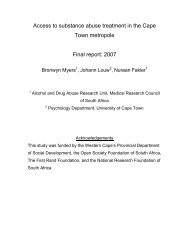Audit of Substance Abuse Treatment Facilities in ... - SA HealthInfo
Audit of Substance Abuse Treatment Facilities in ... - SA HealthInfo
Audit of Substance Abuse Treatment Facilities in ... - SA HealthInfo
- No tags were found...
You also want an ePaper? Increase the reach of your titles
YUMPU automatically turns print PDFs into web optimized ePapers that Google loves.
3.9.2. Monitor<strong>in</strong>g <strong>of</strong> clients’ progress post-treatmentWe also exam<strong>in</strong>ed the extent to which facilities monitored client progress post-treatment.When facilities were asked about post-discharge monitor<strong>in</strong>g and regular post-dischargefollow-up <strong>of</strong> all clients, only 62.5% <strong>of</strong> facilities reported track<strong>in</strong>g client progress oncethey had completed treatment (Figure 24).However, when asked about specific post-treatment monitor<strong>in</strong>g activities, a relativelylarge proportion <strong>of</strong> facilities report monitor<strong>in</strong>g clients’ progress telephonically (93.8%)and monitor<strong>in</strong>g clients’ progress dur<strong>in</strong>g follow-up counsell<strong>in</strong>g sessions (93.8%) (Figure24). In addition, 43.8% <strong>of</strong> facilities report the use <strong>of</strong> blood tests and/or ur<strong>in</strong>alysis tomonitor clients’ substance use and only 18.8% <strong>of</strong> facilities use structured follow-upquestionnaires to track clients’ progress post-treatment.Figure 24.Proportion <strong>of</strong> substance abuse treatment facilities report<strong>in</strong>g monitor<strong>in</strong>g <strong>of</strong>clients post-treatment (%).100908070605040302010063Post-dischargemonitor<strong>in</strong>g andfollow-up9444Telephone follow-up Blood/ur<strong>in</strong>e test Follow-up counsell<strong>in</strong>g Follow-upquestionnaireOverall9419By prov<strong>in</strong>ce, 4 facilities <strong>in</strong> Free State (57.1%), 1 <strong>in</strong> Limpopo (50.0%), 2 <strong>in</strong> Mpumalanga(66.7%), 2 <strong>in</strong> North West (100.0%) and 1 <strong>in</strong> Northern Cape (50.0%) conduct postdischargemonitor<strong>in</strong>g and regular post-discharge follow-up <strong>of</strong> all clients. All facilitiesreport monitor<strong>in</strong>g clients’ progress telephonically, with the exception <strong>of</strong> 1 facility <strong>in</strong>Northern Cape (50.0%). Similarly, all facilities report monitor<strong>in</strong>g clients’ progress dur<strong>in</strong>gfollow-up counsell<strong>in</strong>g sessions, with the exception <strong>of</strong> 1 facility <strong>in</strong> Limpopo (50.0%). Theonly prov<strong>in</strong>ces report<strong>in</strong>g us<strong>in</strong>g blood tests and/or ur<strong>in</strong>alysis to monitor clients’ substanceuse are Free State (42.9%), Limpopo (100.0%) and North West (100.0%). In addition,61
















